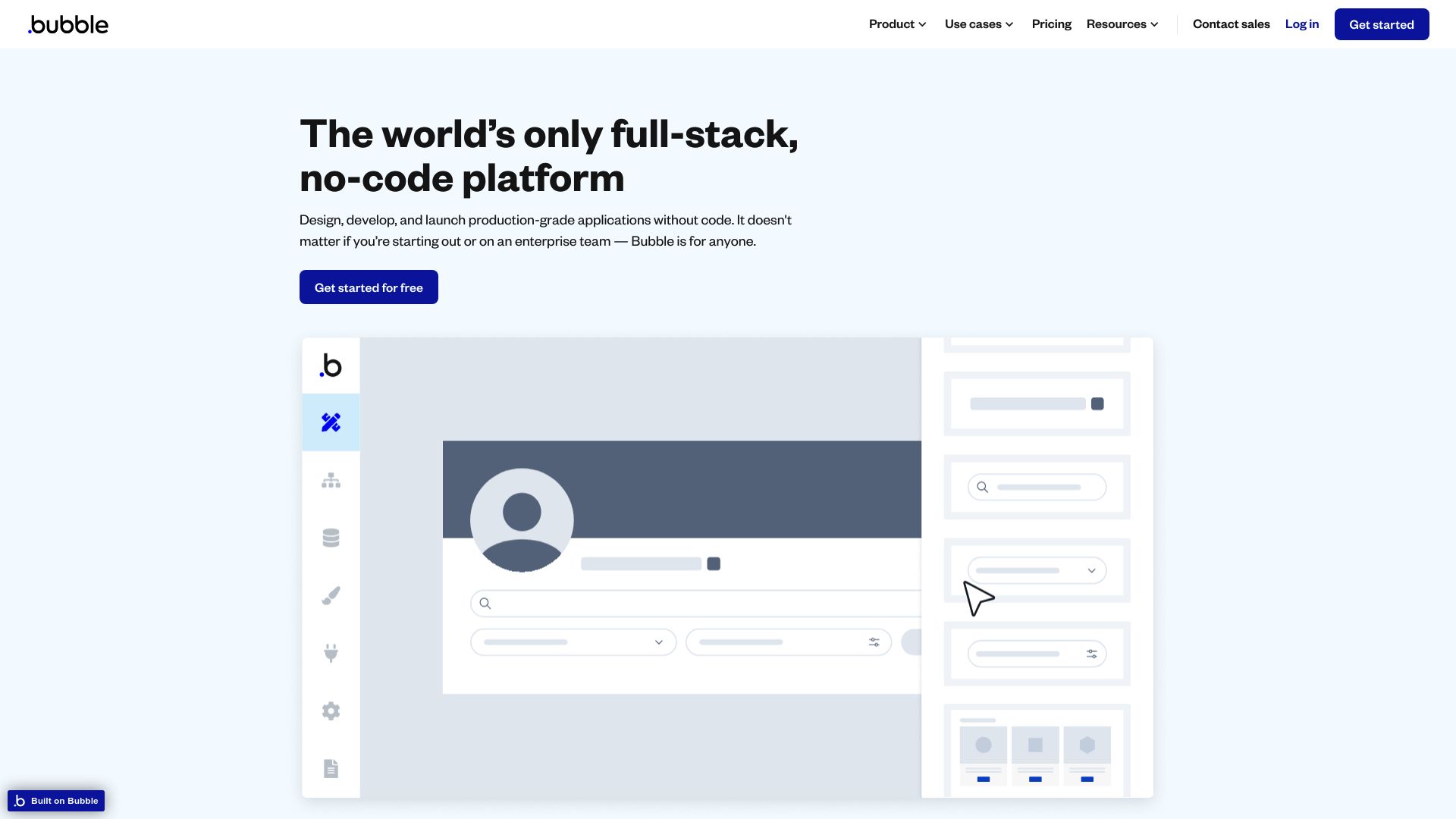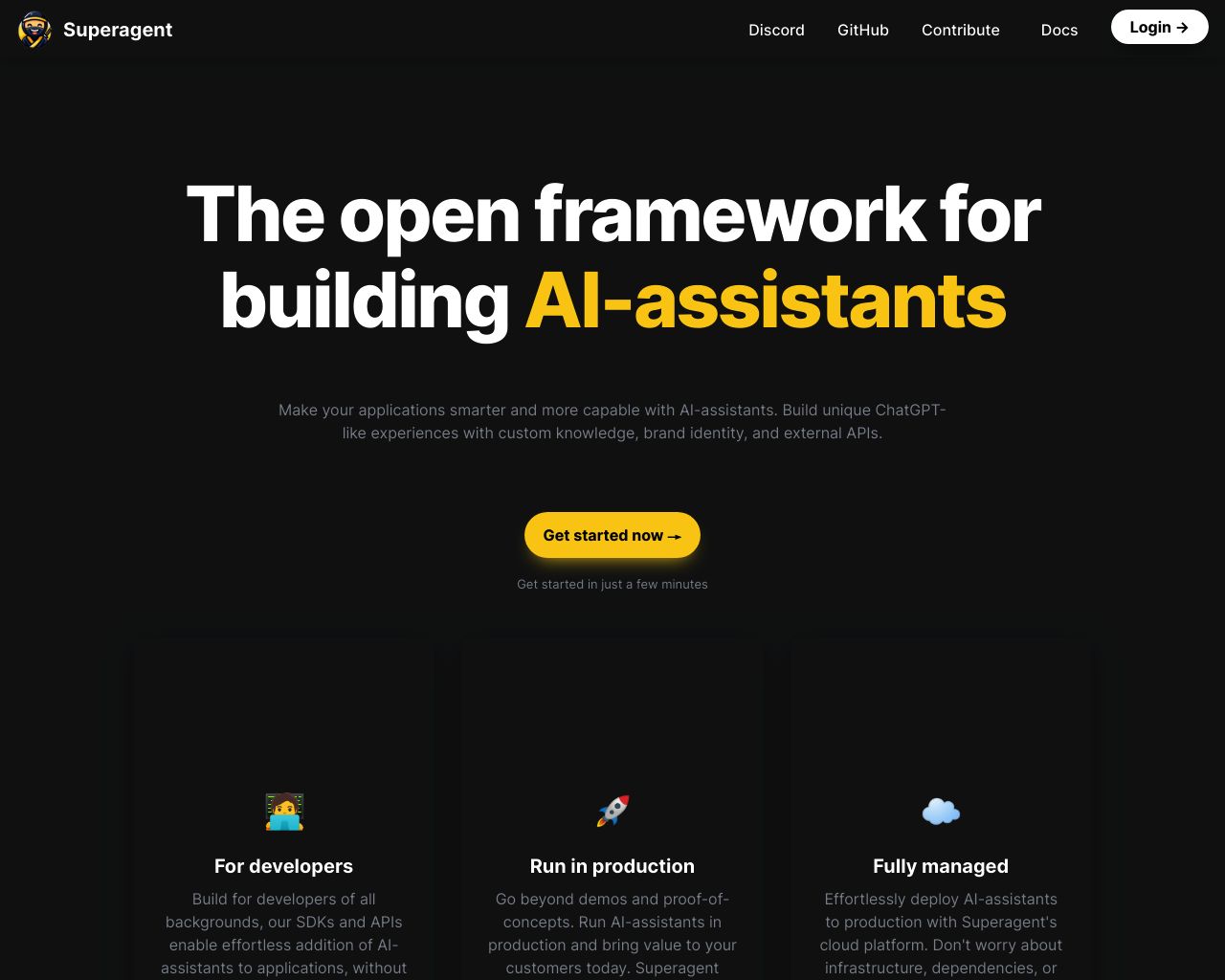Bubble vs. Superagent: Comparing No-Code and AI Agent Platforms
AI-powered tools are reshaping the landscape of software development and business automation. Bubble vs. Superagent represent two distinct approaches to this revolution, each offering unique capabilities for different user needs. Bubble empowers non-technical users to build sophisticated web applications through its visual interface, while Superagent specializes in creating custom AI agents for tasks like web research and sales automation.
This comparison explores how these platforms stack up against SmythOS, a comprehensive solution that combines powerful AI agent creation with user-friendly design tools. We’ll examine their features, strengths, and limitations to help you choose the right platform for your AI and development needs.
Bubble Overview
Bubble empowers users to build web applications without coding. Its visual interface allows drag-and-drop creation of sophisticated apps, making software development accessible to non-technical users. Bubble’s platform integrates AI capabilities through plugins and APIs, enabling features like chatbots and personalized recommendations.
The no-code approach of Bubble democratizes app development, allowing entrepreneurs, business professionals, and creative individuals to bring their ideas to life. Users can create complex workflows, design responsive interfaces, and manage databases—all through an intuitive visual editor. This flexibility supports a wide range of applications, from simple prototypes to scalable, production-ready software.
Bubble empowers users to build web applications without coding. Its visual interface allows drag-and-drop creation of sophisticated apps, making software development accessible to non-technical users.


Bubble’s strength lies in its balance of power and accessibility. The platform offers robust features for data management, user authentication, and third-party integrations. It supports both development and production environments, allowing users to test and refine their applications before launch. The ability to deploy applications as APIs or integrate with external services expands the platform’s utility for businesses looking to enhance their digital presence.
Bubble’s strength lies in its balance of power and accessibility. The platform offers robust features for data management, user authentication, and third-party integrations.
While Bubble excels in web application development, it has limitations in specific AI agent functionalities. The platform doesn’t offer hosted AI agents or autonomous agent capabilities out of the box. Users seeking advanced AI features like explainable AI or multi-agent collaboration may need to explore additional integrations or alternative platforms. Despite these constraints, Bubble’s extensibility through plugins and API connections allows for significant AI enhancement of applications, making it a versatile choice for many development needs.
Superagent Overview
Superagent empowers companies to build custom AI agents for web research, sales, marketing, and project management without coding expertise. The open-source platform enables AI agents to autonomously browse the web, access files, and seamlessly integrate with tools like Airtable, Salesforce, and various APIs.


Superagent’s standout feature lies in its simplicity. Users can customize AI agents using straightforward markup, making the technology accessible to non-AI experts. The platform offers robust integration options, including an API and SDKs for embedding AI agents into various applications.
Superagent’s standout feature lies in its simplicity. Users can customize AI agents using straightforward markup, making the technology accessible to non-AI experts.
The platform automates complex tasks traditionally requiring significant manual effort. It streamlines sales processes by gathering detailed customer information, personalizes marketing efforts through CRM integration, and conducts competitive analysis by tracking market trends. Superagent also facilitates private equity research, patent tracking, content aggregation, and talent acquisition by automating data collection and analysis.
While Superagent offers powerful capabilities, it lacks some features found in more comprehensive platforms. It doesn’t provide hosted agents for development or production environments, and it doesn’t offer a visual builder or no-code editor. The platform also lacks built-in memory and context management for AI agents, which could limit their ability to maintain long-term context in conversations.
Founded in 2023 and based in San Francisco, Superagent aims to democratize AI usage. The company’s vision focuses on making AI accessible and practical for all businesses, regardless of technical expertise. This approach helps companies save operational costs, improve efficiency, and maintain a competitive edge through enhanced internal workflows and customer experiences.
Feature Comparison
Bubble and Superagent offer distinct approaches to application development and AI integration. Bubble excels in no-code web application development with its visual interface and extensive integration options. It provides both development and production environments, allowing users to build and deploy web applications without coding. Bubble’s strength lies in its visual builder and no-code editor, making it accessible to non-technical users.
Superagent, on the other hand, focuses on building custom AI agents for specific tasks like web research, sales, and marketing. It offers a more specialized approach to AI integration, allowing users to create autonomous agents that can browse the web and interact with various tools and APIs. However, Superagent lacks some of the core features that Bubble provides, such as a visual builder or no-code editor.
A significant gap between the two platforms lies in their AI capabilities. While Bubble allows integration with AI services through plugins and APIs, it doesn’t offer built-in AI agents or autonomous agent capabilities. Superagent, being designed specifically for AI agent creation, provides these features out of the box. This makes Superagent more suitable for users looking to develop sophisticated AI agents, while Bubble is better suited for general web application development with the option to add AI functionalities through integrations.
Feature Comparison Table
| Bubble | Superagent | SmythOS | |
|---|---|---|---|
| CORE FEATURES | |||
| Visual Builder | ✅ | ❌ | ✅ |
| Memory & Context | ❌ | ✅ | ✅ |
| Autonomous Agents | ❌ | ✅ | ✅ |
| Explainability & Transparency | ❌ | ❌ | ✅ |
| Multimodal | ❌ | ✅ | ✅ |
| Multi-Agent Collaboration | ❌ | ✅ | ✅ |
| Audit Logs for Analytics | ✅ | ❌ | ✅ |
| Bulk Work | ❌ | ✅ | ✅ |
| Agent Work Scheduler | ❌ | ✅ | ✅ |
| SECURITY | |||
| Constrained Alignment | ❌ | ❌ | ✅ |
| IP Control | ❌ | ✅ | ✅ |
| COMPONENTS | |||
| Huggingface AIs | ❌ | ✅ | ✅ |
| Classifiers | ❌ | ✅ | ✅ |
| Data Lakes | ✅ | ❌ | ✅ |
| DEPLOYMENT OPTIONS (EMBODIMENTS) | |||
| Deploy as API | ❌ | ✅ | ✅ |
| Staging Domains | ✅ | ❌ | ✅ |
| Deploy as Scheduled Agent | ❌ | ❌ | ✅ |
| DATA LAKE SUPPORT | |||
| Hosted Vector Database | ❌ | ✅ | ✅ |
| Sitemap Crawler | ❌ | ✅ | ✅ |
| YouTube Transcript Crawler | ❌ | ✅ | ✅ |
| URL Crawler | ❌ | ✅ | ✅ |
Best Alternative to Bubble and Superagent
SmythOS stands out as the superior alternative to Bubble and Superagent, offering a comprehensive platform for AI agent development and deployment. We combine the best of both worlds — the visual building capabilities of Bubble and the AI agent focus of Superagent — while providing additional features that set us apart.
Our drag-and-drop interface makes AI agent creation accessible to users of all technical backgrounds, similar to Bubble’s approach. However, we take it further by offering advanced AI capabilities, including autonomous agents, multi-agent collaboration, and support for various AI models. This combination allows users to create sophisticated AI solutions without extensive coding knowledge.
SmythOS stands out as the superior alternative to Bubble and Superagent, offering a comprehensive platform for AI agent development and deployment.
Unlike Bubble, which lacks built-in AI agent capabilities, or Superagent, which doesn’t offer a visual builder, SmythOS provides a complete ecosystem for AI development. Our platform supports a wide range of deployment options, from APIs and webhooks to scheduled agents and site chats, giving users the flexibility to integrate AI into various applications and workflows.
We prioritize scalability and security, essential features for enterprise-level deployments. Our platform includes features like constrained alignment, data encryption, and IP control, ensuring that AI agents operate within defined parameters and adhere to security protocols. This makes SmythOS suitable for businesses of all sizes, from startups to large corporations.
Our extensive integration capabilities, including support for various APIs, data lakes, and vector databases, provide users with unparalleled flexibility in connecting AI agents to existing systems and data sources. This versatility, combined with our multimodal capabilities and problem-solving features, enables the creation of AI agents that can handle complex tasks across different industries and use cases.
Conclusion
Bubble and Superagent offer unique approaches to application development and AI integration, each with its strengths. Bubble excels in no-code web application development, providing an intuitive visual interface for users to create sophisticated apps without coding expertise. Its extensibility through plugins and API connections allows for AI enhancement, making it a versatile choice for general web application needs.
Superagent, focusing on building custom AI agents, provides a specialized platform for creating autonomous agents that can perform tasks like web research and marketing automation. Its simplicity in customization using markup language makes it accessible to non-AI experts, offering robust integration options for various business tools.
However, SmythOS emerges as the superior choice, combining the best of both worlds and offering additional advanced features. Our platform provides a comprehensive solution for creating and deploying AI agents with a user-friendly drag-and-drop interface, extensive integration capabilities, and support for multiple AI models. SmythOS excels in areas where Bubble and Superagent fall short, offering hosted agents, multi-agent collaboration, and advanced features like explainable AI and problem-solving capabilities.
For businesses and developers looking to harness the full potential of AI while maintaining flexibility and ease of use, SmythOS stands out as the ideal solution. We invite you to explore our diverse range of AI-powered agent templates and experience unlimited AI automation risk-free with our generous free plan. Discover 300,000+ seamless integrations for your AI workflow and deploy AI agents anywhere with our versatile platform. Take the first step towards revolutionizing your workflow with SmythOS today.
Last updated:
Disclaimer: The information presented in this article is for general informational purposes only and is provided as is. While we strive to keep the content up-to-date and accurate, we make no representations or warranties of any kind, express or implied, about the completeness, accuracy, reliability, suitability, or availability of the information contained in this article.
Any reliance you place on such information is strictly at your own risk. We reserve the right to make additions, deletions, or modifications to the contents of this article at any time without prior notice.
In no event will we be liable for any loss or damage including without limitation, indirect or consequential loss or damage, or any loss or damage whatsoever arising from loss of data, profits, or any other loss not specified herein arising out of, or in connection with, the use of this article.
Despite our best efforts, this article may contain oversights, errors, or omissions. If you notice any inaccuracies or have concerns about the content, please report them through our content feedback form. Your input helps us maintain the quality and reliability of our information.
